As a regular follower of many international tech sites and forums, I’ve grown fond of a few regular features put out by many of them.
One of my favorite out of these is the monthly best graphics card for your money round up by Toms Hardware. It takes the current crop of graphics cards available in the market, and gives you a recommendation based or performance for each price point. Though I love this series, it was always difficult to translate said article for use in the local market due to widely varying price segments.
So, why not make up a list on our own to suit the local market? This is exactly what we did. As someone who deals with the latest hardware on a daily basis, all of these recommendations come from first hand gaming experience with the latest gaming titles. Firstly, we’ve put together a chart analyzing the price and 3DMark performance of what’s available on the market, like so:
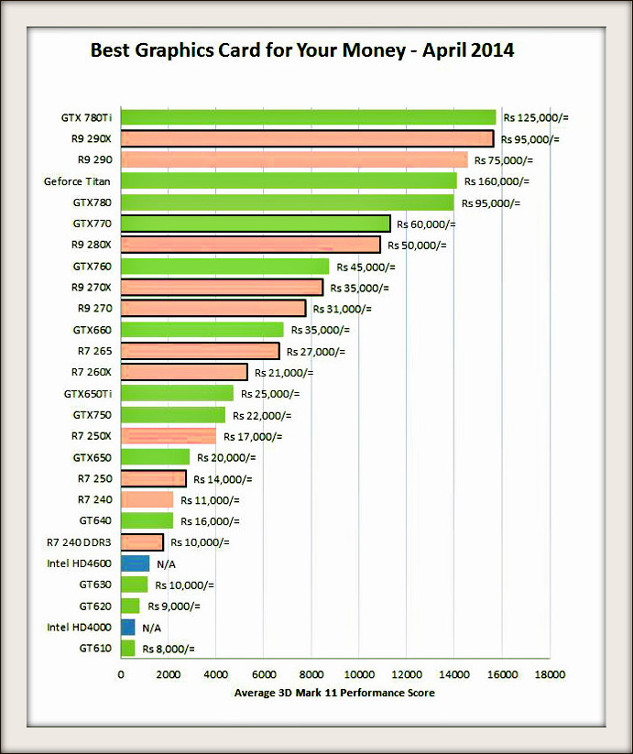
But 3DMark performance isn’t everything. We’ve assembled our list of the best value-for-money cards out there, all the way from Rs 10,000 to Rs 100,000. We’ve also included the recommended processor, monitor and power supply pairing to go with the selected graphics card, so that you can adjust your budget accordingly if you are planning a new system.
So let’s roll out.
Rs 10,000/= or below
Max settings on any game below 1366×768. Good performance (medium/high) on all the latest games at 1366×768. Entry level performance at 1980×1080.
What can you buy for less than 10k? Mostly, crap. Honestly, there is very little for under 10k to be had in terms of gaming. This price segment is populated by the ancient G210s, GT520s, HD5450s, HD6450s and the newer (but equally bad) GT610s and GT620s.
Why are none of these recommended? To put it into perspective, the Intel HD Graphics present on the current generation Pentium processors will give you better graphics performance than all those older gen cards. And that processor itself costs only Rs 8,000/=. So avoid these at all costs. The GT610 and 620 redeem themselves a bit, but again, these are bested by Intel HD4400 graphics found on a current gen Core i3 processor, and are only viable if you are looking for a cheap performance bump for an old Core 2 Duo PC.
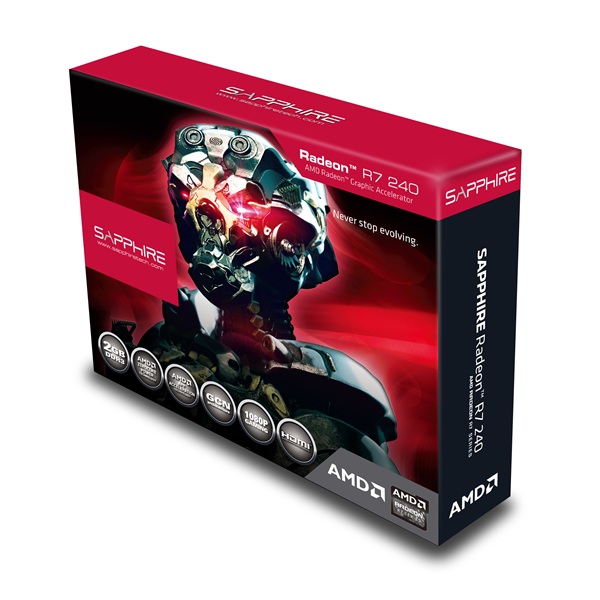 So what do we recommend for 10k? Enter the Radeon R7 240. Costing just Rs 10,000/= this card simply massacres the competition in every sense of the word. It’s closest competitor? The GT640, which costs whopping 6k more. This also means the R7 240 easily gives you around 3-4x the performance of a GT62 0 available for around the same price.
So what do we recommend for 10k? Enter the Radeon R7 240. Costing just Rs 10,000/= this card simply massacres the competition in every sense of the word. It’s closest competitor? The GT640, which costs whopping 6k more. This also means the R7 240 easily gives you around 3-4x the performance of a GT62 0 available for around the same price.
If you are stuck at below 10k, our recommendation would be to push somehow and reach 10k. If it’s impossible, you better off looking in the used market for something like a GTS450 or HD6770 which are commonly available for 7-8k.
Recommendation:
Radeon R7 250 1GB GDDR5
Our pick:
Sapphire Radeon R7 240 1GB GDDR3 – Rs 10,000/=
Recommended processor:
4th Generation Intel Pentium G3220 or AMD Athlon II 750K
Recommended Monitor Resolution:
1366×768
Recommended Power Supply:
250W
Best graphics card for Rs 15,000/=
Max settings on any game at 1366×768. Good performance on all the latest games at 1980×1080.
Let’s jump another 5k and see what’s available. This money buys you various memory configurations of the GT630, the HD7730, R7 250 and pushing a little bit more will give you a GT640.
The standout performer there is undoubtedly the Radeon R7 250. Essentially, it’s an overclocked and rebranded HD7730. In our testing, the HD7730 never managed to overclock beyond 1GHz. However, the R7 250 has managed a clock of 1150MHz out of the box, with the potential of overclocking further, making it faster than the already brilliant HD7730. As for the NVidia duo, they are reduced to mere bystanders. The lowly R7 240 handsomely beats a GT630 while the R7 250 beats the GT640 by an even bigger margin. The R7 250 nips on the heels of the GTX650 which manages to sell above Rs 20,000/=

Recommendation:
Radeon R7 250 1GB GDDR5
Honorable Mention
Radeon HD7730 1GB DRR5 – if you overclock
Our Pick:
Sapphire Radeon R7 250 1GB GDDR5 – Rs 14,000/=
Recommended processor:
4th Generation Intel Core i3 4130 or AMD FX-6300
Recommended Monitor Resolution:
1366×768 or 1600×900
Recommended Power Supply:
250W
Best Graphics card for Rs 20,000/=
Max settings on any game at 1366×768. Good performance (high) on all the latest games at 1980×1080.
20k is the sweet spot for graphics card in our market. So whatever goes here will undoubtedly be the crowd favorite.
So what can you get in between 15 and 20k? The R7 250X (which is a rebranded HD7770), various memory configurations of the GT640 and the GTX650. Since the R7 250 we mentioned in the previous price category easily beats a GT640 and matches a GTX650, we already know that this level of performance is available below Rs 15k, which means the GT640 and GTX650 are already bad buys. That leaves the R7 250X aka HD7770 which sells for slightly below Rs 20k.
But do we recommend the R7 250X as the best card for 20k? Not exactly, because just beyond that barrier of 20k lies a beast ready to pounce and devour anything that crosses its path. Enter the R7 260X.
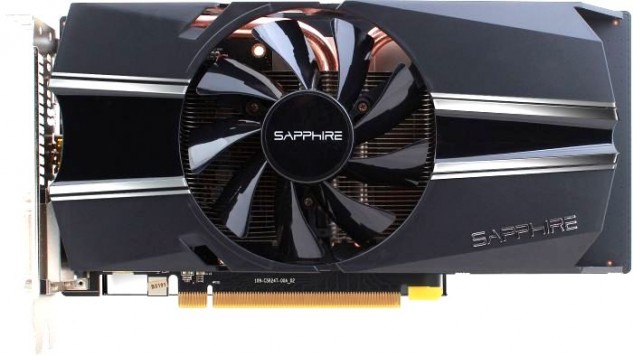
A re-engineered HD7790, this card simply destroys anything in the range of 20K, easily beating most of the cards we will discuss in the next price category. for about the same price of a GTX650, you get something around 30% faster (faster than a GTX650Ti or a GTX750) and a card capable of running 90% of today’s games at max settings on a full HD monitor. For 21k, no brainer. R7 260X owns.
Recommendation:
Radeon R7 260X 1GB GDDR5
Honorable Mention
Radeon R7 250X 1GB GDDR5 – if you really can’t stretch that extra 4k for a 260X.
Our Pick:
Sapphire Radeon R7 260X 1GB GDDR5 – Rs 21,000/=
Recommended processor:
4th Generation Intel Core i3 4130 or AMD FX-6300
Recommended Monitor Resolution:
1600×900 or 1920×1080
Recommended Power Supply:
350W
Best Graphics card for Rs 27,000/=
Exceptional performance (high/ultra) on all the latest games at 1980×1080. Entry level performance at 2560×1440.
Why not 25k? Easy. The R7 260X happened. Let’s look at the contenders for the crown between 20 and 25k. GTX750? R7 260X is faster. GTX650Ti? R7 260X is faster. Various GTX650 models are also available at this price range, but your IQ needs to be really low for you to even consider one.
So what do we buy if we can’t go over 25k? An R7 260X. There are a few models with 2GB memory available for slightly more than the 1GB version, but these are best left for cases which involve a 1440p aka “2K’ monitor. Since this utter domination was brought upon us by the 260X, we look towards something slightly more expensive to give ourselves a decent performance bump. The R7 265.
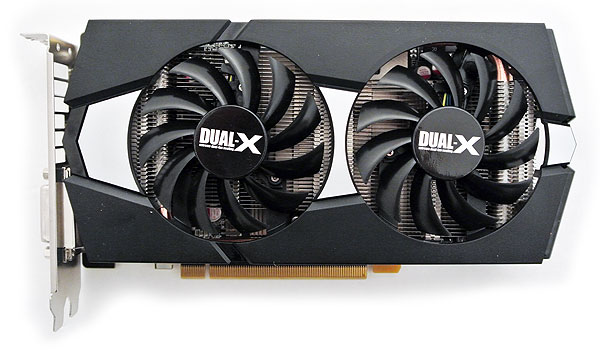
The R7 265 is the reincarnation of an old favorite, the Radeon HD7850. Sporting the same silicon, it also sports the same legendary overclocking prowess. All R7 265s we tried overclock to 1050MHz out of the box, putting them on par with an overclocked GTX660 or a stock R9 270! Yes this thing matches a card which costs over 40% more! For 27k, this is the best buy out there for less than 30k.
Recommendation:
Radeon R7 265 2GB GDDR5
Honorable Mention
GeForce GTX750 1GB GDDR5 – Sower than a 260X, but only draws 55W. A good solution if you are running a low end power supply or building a low power system.
Our Pick:
Sapphire Radeon R7 265 Dual-X 2GB GDDR5 – Rs 27,000/=
Recommended processor:
4th Generation Intel Core i3 4130 or AMD FX-6300
Recommended Monitor Resolution:
1920×1080
Recommended Power Supply:
400W (450W if overclocking)
Best Graphics card for Rs 30,000/=
Ultra settings on almost all the latest games at 1980×1080. Good performance (medium) at 2560×1440.
Now we are into enthusiast territory. The average gamer rarely ventures to the territory above 30k when looking for a graphics card. What’s available for this sort of money? We have two cards from both camps going head to head with each other. The GTX650Ti Boost for around Rs 28k and the Radeon R9 270 for 31k.
So considering the 3k price difference between the cards, which is better? Once again, no competition and no deliberation. The GTX650Ti Boost takes a solid beating from the R7 265 we discussed previously, so this round goes to the R9 270, which manages to consistently beat even a GTX660 across modern titles.

It’s important to note that there’s one competitor pending arrival in this price range, the GTX750Ti. It’s well documented that even this is slower than the R7 265, but the ultra-low power consumption and alleged superior overclocking ability could earn this a recommendation or at least an honorable mention in the months to come. Our recommendation for now is that you add a thousand bucks to that 30K budget and go for the R9 270.
Recommendation:
Radeon R9 270 2GB GDDR5
Our Pick:
Sapphire Radeon R9 270 Dual-X 2GB GDDR5 – Rs 31,000/=
Recommended processor:
4th Generation Intel Core i5 4570
Recommended Monitor Resolution:
1920×1080
Recommended Power Supply:
450W
Best Graphics card for Rs 40,000/=
Ultra settings on all the latest games at 1980×1080. Good performance (medium/high) at 2560×1440.
This is the price point where you are looking to max out everything on a full HD monitor. The current market has two cards selling in this price range, again from the two competitors. The GTX660 and the R9 270X.
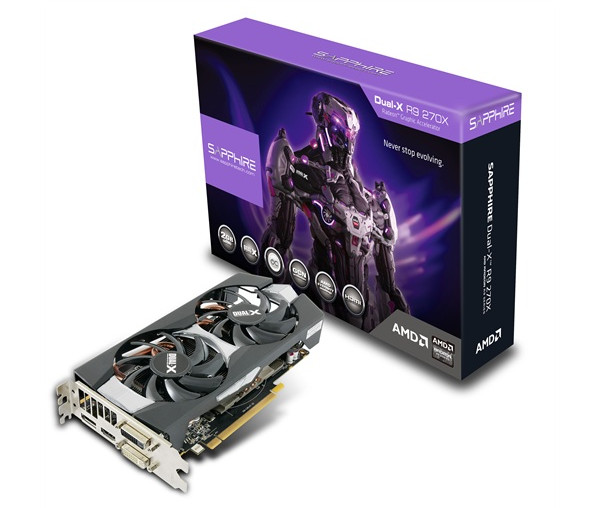
Once again, if you read the previous section you’ll know that the GTX660 is already beaten by the R9 270 which can be bought for 31k. So at 35k, the R9 270X easily beats the similarly priced GTX660 while only falling slightly short of the much more expensive GTX760 and earns our recommendation as the best card under Rs 40k
Recommendation:
Radeon R9 270X 2GB GDDR5
Our Pick:
Sapphire Radeon R9 270X Dual-X 2GB GDDR5 – Rs 35,000/=
Recommended processor:
4th Generation Intel Core i5 4570 or i5 4670K
Recommended Monitor Resolution:
1920×1080 or 2560×1440
Recommended Power Supply:
500W
Best Graphics card for Rs 50,000/=
Ultra settings on all the latest games at 1980×1080. Exceptional performance (Ultra/high) at 2560×1440.
This is the land of the 2k displays. This is enough money to buy you a card that packs enough of a punch to deliver ridiculously high frame rates in the latest and greatest gaming titles on a full HD monitor (think 70+ FPS on BF4) or great performance on a 2K monitor.
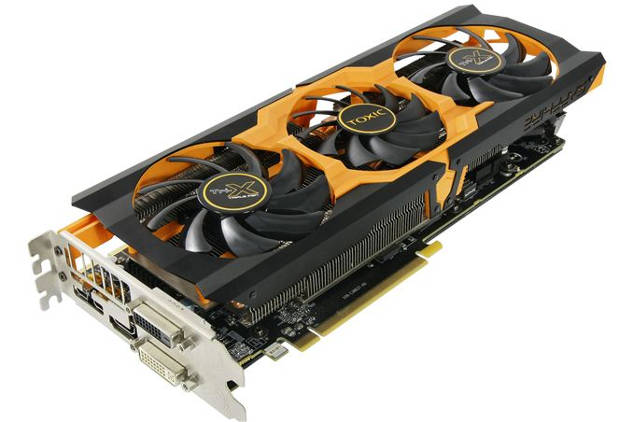
In the green corner, we have the GeForce GTX760, while the competitor from the red corner is the Radeon R9 280X. There goes the bell and the match begins! BOOM. One punch. Knockout. Match over. The GTX760 is carried away on a stretcher in a coma from which it won’t wake up for a couple of decades. That’s how one sided this matchup is.
The R9 280X so much more powerful than a GTX760 it has no right to be in this fight. For a few thousand more than a GTX760 you get a card that gives on average 15-20% more performance on a full HD monitor or over 25% on a higher resolution and with a little bit of overclocking knocks on the door of a GTX770. The Toxic edition (pictured above) is more expensive and represents the potential of the 280X. We recommend the Dual-X version.
Recommendation:
Radeon R9 280X 3GB GDDR5
Our Pick:
Sapphire Radeon R9 280X Dual-X 2GB GDDR5 – Rs 50,000/=
Recommended processor:
4th Generation Intel Core i5 4570 or i5 4670K
Recommended Monitor Resolution:
1920×1080 or 2560×1440
Recommended Power Supply:
550W
Best Graphics card for Rs 60,000/=
Ultra settings on almost all the latest games at 2560×1440. Great performance (high) at 5760×1080 (triple monitor). Entry level performance (medium) at 3840×2160.
The 60k region has one solitary competitor. The GeForce GTX770. A card sufficiently powerful to max out games at 2k resolutions and a great entry into 4k. Also a great card for an inexpensive triple monitor gaming setup.

If you really want to pick a competitor from the opposing camp, you can pick up an overclocked version of a R9 280X (like a Sapphire Toxic or Asus ROG Matrix) which will give you equal or sometimes better performance than a GTX770. But still, we’ll give our recommendation to the GTX770 unless you can find a custom R9 280X for significantly less.
Recommendation:
GeForce GTX770 2GB GDDR5
Our Pick:
MSI GeForce GTX770 Twin Frozr Gaming 2GB GDDR5 – Rs 63,000/=
Recommended processor:
4th Generation Intel Core i5 4570 or i5 4670K
Recommended Monitor Resolution:
2560×1440 or 5760×1080
Recommended Power Supply:
550W
Best Graphics card for Rs 75,000/=
Ultra settings on all the latest games at 2560×1440 and at 5760×1080 (triple monitor). Solid performance (high/ultra) at 3840×2160.
75K. that’s a LOT of money. Who spends this much on a graphics card? Well, you’d be surprised as to the number of people interested -and more importantly- capable of buying these. What will 75k buy? A Radeon R9 290. How fast is it? Have you ever heard of something called a GeForce Titan? Of course you have. Well, the R9 290 performs roughly on par with a Titan while costing just half as much. Yes. This card. Matches a Titan. And costs 75k. Next!
Recommendation:
Radeon R9 290 4GB GDDR5
Our Pick:
Sapphire Radeon R9 290 Tri-X 4GB GDDR5 – Rs 76,000/=
Recommended processor:
Overclocked 4th Generation Intel Core i5 4670K
Recommended Monitor Resolution:
2560×1440, 5760×1080 or 3840×2160
Recommended Power Supply:
550W
The Final Trophy: the Best Graphics card for Rs 100,000/=
Ultra settings on just about anything
Yup, people DO buy these things. Otherwise they wouldn’t be around. For about the same money which you could buy a decent gaming PC, you can buy either a Radeon R9 290X or a GTX780. The R9 290X is the current top dog of the Radeon lineup and brushes shoulders with the GTX780Ti which costs 30k more (at this point you can safely assume that the 780Ti is not getting a recommendation). The GTX780 is easily beaten by the R9 290 at the 75k price point, so there’s really no point paying the extra ~20k for a GTX780.
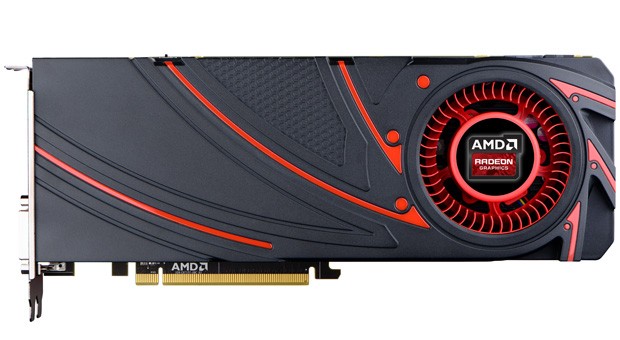
So does this leave the R9 290X as the best graphics solution you can buy at 100k? Not quite. Not since some smart guy (literally) decided to put two graphics cards in his PC. 100k will buy you a pair of R9 280Xs. Hook these up with a Crossfire connector and you have enough horsepower to run a school bus. Two R9 280Xs in crossfire easily outpace the R9 290X and GTX780Ti by around 20-25%.
However, there are inherent flaws in running a dual card setup. You need a bigger power supply, a Crossfire supported motherboard, a case with sufficient cooling for two cards, and you always have to wait for a couple of weeks after a game is released for it to support multiple graphics cards. Some older and not so popular games have issues with multi graphics setups, but a single R9 280X should be able to do away with these easily.
Recommendation:
2x Radeon R9 280X 3GB GDDR5 in Crossfire
Honorable Mention
Radeon R9 290X 4GB GDDR5
Our Pick:
2x Sapphire Radeon R9 280X Dual-X 2GB GDDR5 in Crossfire
Recommended processor:
Overclocked 4th Generation Intel Core i5 4670K or i7 4820K
Recommended Monitor Resolution:
2560×1440, 5760×1080 or 3840×2160
Recommended Power Supply:
800W for crossfire, 600W for 290X







Will you be doing this monthly too? Or bi-monthly/every quarter? In short, will there be a system to these posts Or will you just whenever you feel like it / enough change in GFX card market has occurred?
I can understand Toms Hardware doing this every month, they have an IMMENSE crowd to cater to that more or less can use their local currencies interchangeably against the dollar. Sri Lanka is, according to scale, tiny.
As it stands great article, especially the observations (the chart really doesn’t help much without the article as a reference) if this keeps up I can finally let go of TH/AnandTech/Xbit and rely on this!
Thanks for reading. We’ll be doing this feature whenever enough change happens in the local market – such as the introduction of a new card, price drops, etc.
Yes, Sri Lanka is a tiny market, so we don’t really see enough change to do this monthly – but given that these happen every 6 months or so, with places like Redline Technologies driving the change, you can certainly rely on us to deliver as soon as the balance shifts 🙂
No bad article , thing is that when u shop around for a card , you cant get what u want since most of the stuff are not available in SL . I hope that someday we can get stuff on ebay ( online shopping) , with some reasonable tax rates . Thanks for the article , where did u get the performance graphs ?? and are these cards available in SL .. where ???
All the products recommended in this article are available in the country, otherwise the point of such an article is lost. Most of the lower end cards are available in any decent PC store. For the higher end stuff, I’ll direct you towards Redline Technologies.
The graph has been derived from data found on http://www.futuremark.com/hardware/gpu.
Very helpful guide. But the r7 250 has 2 variants as i know d5 and d3. It will be very helpful if thats mentioned as the price difference is considerable.